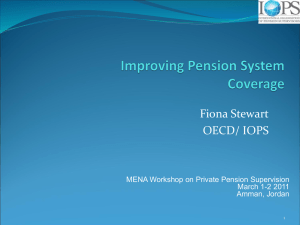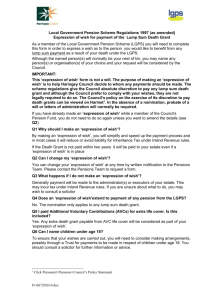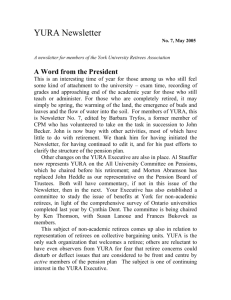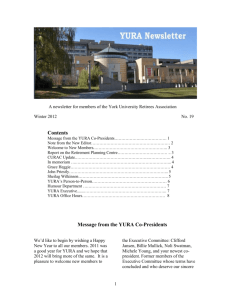03 March 2002 - York University Retirees Association
advertisement
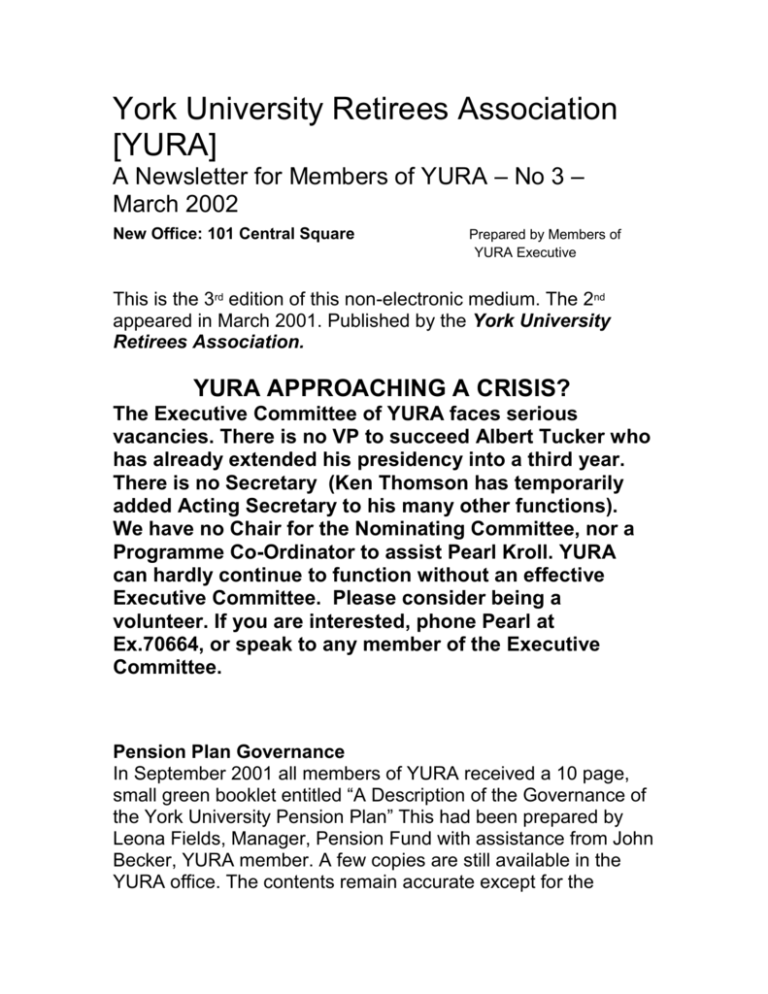
York University Retirees Association [YURA] A Newsletter for Members of YURA – No 3 – March 2002 New Office: 101 Central Square Prepared by Members of YURA Executive This is the 3rd edition of this non-electronic medium. The 2nd appeared in March 2001. Published by the York University Retirees Association. YURA APPROACHING A CRISIS? The Executive Committee of YURA faces serious vacancies. There is no VP to succeed Albert Tucker who has already extended his presidency into a third year. There is no Secretary (Ken Thomson has temporarily added Acting Secretary to his many other functions). We have no Chair for the Nominating Committee, nor a Programme Co-Ordinator to assist Pearl Kroll. YURA can hardly continue to function without an effective Executive Committee. Please consider being a volunteer. If you are interested, phone Pearl at Ex.70664, or speak to any member of the Executive Committee. Pension Plan Governance In September 2001 all members of YURA received a 10 page, small green booklet entitled “A Description of the Governance of the York University Pension Plan” This had been prepared by Leona Fields, Manager, Pension Fund with assistance from John Becker, YURA member. A few copies are still available in the YURA office. The contents remain accurate except for the membership of the various committees. For instance Frances Bukovec has replaced Diane Taylor as the YURA member on the All University Committee on Pensions (AUCP). See the YURA executive list for contact numbers for all reps and executive members. What’s Coming Up in 2002? 2002 is proving to be another eventful year for our members. Please remember that all out-of-town trips come with YURA chartered bus service. •Fitness (twice a week) to the enjoyment of all has added a few more to their numbers. •Niagara on the Lake - Caesar & Cleopatra on Wednesday, 24 April; price TBA •Walk with John Warkentin in & around the U of T area: Thursday, 23 May; rain or shine; start time & meeting spot TBA. •Casino Rama - Thursday, 6 June. •Stratford Festival - King Lear, Thursday, 6 September, price TBA •Computer programs will be offered again and start dates will be announced by mail. Change in Mortality Table to Determine Pension Benefits Many of you are aware of the controversy about mortality tables. All pensions everywhere are based on predictions of how long people are going to live. As life expectancy increases this change is reflected in updated mortality tables. Actuaries advise about these changes and recommend ways of keeping pension plans financially healthy in the face of long living retirees. The proposal that was made to the York Pension Plan was to reduce annual pension increments by 0.25% to cover costs due to longer living retirees. This was accepted for only those who retire after 1 January 2001. Existing retirees are not affected. It should be noted that this discussion about revised life expectancy is not new to York. A revised mortality table was adopted by York in the early 1990s and phased in over 3 years. And, similar to now, at that time no reduction in existing annual pension increments was required. There is no escaping the fact however that, as our life expectancy increases, the contributions we and the university have made to the pension plan (which are only altered by fund earnings after we retire) must be spread over more years the longer we live. But with luck changes to mortality tables will continue! YURA Membership Counts YURA membership as of February 22, 2002 is: CPM 50 CUEW/CUPE 3903 2 CUPE [1356 & 1356-01] 22 IUOE 2 OHFA 1 RASOC 3 RASST 2 YUFA 172 YUSA 132 Spouses & Others 12 Total: 398 Retirement Planning Centre Karen Gray and How Chee Un are the helpful staff of the RPC and may be reached at 416-736-2100 e.66228; email <retire@yorku.ca>; 101 Central Square. They offer a wide range of programs dealing with financial planning, computer skills, recreation and many other topics. The Executive 2001-2002 Contact any of the executive for more information about the YURA. 416-921-1887; atucker@gl.yorku.ca 416-241-6331; kthomson@yorku.ca -771-5241 Pension Committee, 416-633-2225, fbukovec@yorku.ca 416-496-0261; pkroll@yorku.ca -924-1588; amurray @yorku.ca 905-888-1291 -889-5216; gechard @yorku.ca -638-0737; ngc@yorku.ca -936-5133; taylor5133@rogers.com Ex Officio: 416-932-1754; jbecker@interlog.com -456-6474; jwaiken@ sympatico.ca * Also available during the day at the YURA Office in 101 Central Square; 416-736-2100 e.70664 All University Group on Benefits Ken Thomson has been active with this “sometimes here & sometimes there” group since the very beginning back in 1996. The idea was that the various employee groups at York would join in discussions about the “non-pension benefits”. Not all employee groups have recognized the value of such information sharing and the group has never achieved “official” status although Thomson, Murray and Bukovec, all of the YURA executive, continue to campaign for such information sharing. Not surprisingly York is ambivalent about dealing with such group in any official way. Reason: all employee groups have in the past negotiated separately for “non-pension benefits”. Unlike pensions which follow the same formula for all retirees regardless of their employee group (union, non-union, faculty, staff, et al.), “non-pension benefits” [extended health, vision care, dental, etc.] vary from group to group and then vary again after retirement! And the funding of these benefits is entirely different from the pension benefits which are derived from a contributory invested trust fund. For non-faculty employees and retirees the university’s “Non-pension benefits” are paid for by the university and are not contributory. (Faculty are part of a contributory system before and after retirement.) Work continues on a chart which attempts to compare and contrast the post-retirement “non-pension benefits” of all retired members of all employee groups but since some groups bargain for changes when their contract comes up for renewal, the chart is a “moving target”. When Ken Thomson concludes his work on it representatives of the various employee groups (and their retired members too) may be stimulated to meet more regularly to share more information. Footnote: See the last newsletter for info on a YURA SubCommittee on Post-Retirement Benefits [extended health, vision care, dental, etc.] which included a YURA Executive member from each of YUFA, CPM and YUSA. Activities and Programs in 2001 A Recap •The fitness program was successfully ongoing in 2001. •Niagara on the Lake on 8 June to see the Millionairess [sold out]. •Computer programs were offered in May, June, October and December 2001. •Showcase 2001 was held 7 November in conjunction with the 15th Anniversary of YURA and was a great success. •A Cook Book was published & sold by “the YURA team” in recognition of the 15th Anniversary of YURA. •Stratford Festival on 7 September to see Twelfth Night [sold out]. •"Lilactree Farm" & "Boyne Mill Garden" Garden Tour & Rural Landscape Excursion, on 3 July. •Tour of Early Toronto Religious Structures on 24 October. More on Pensions & Benefits “Shadow Pension” and the “Non-Reduction Provision” have recently become hot topics and deserve some definition. These terms are entwined together. First, there has always been a concept of a “shadow pension”, properly known as the “pension payable”, running in parallel with the actual “pension paid” when the four-year average earnings of the Fund are insufficient to pay “the same pension as was paid the previous year” and comply with the “Non-Reduction Provision”. Because of this provision, funds must be found elsewhere to pay the current year pensions. Both the non-reduced “pensions paid” and the lower “pension payable” are thereafter tracked, and there is no increase in pensions actually paid until the cumulative “pension payable” catches up and passes the cumulative “pension paid” figure. In other words, any earnings which will permit increases are applied to the “debt” and until that is cleared, the “pension paid” is effectively “red-circled”. These funds are “borrowed” from a special fund created by the university as of January 1,1992 which saw their contribution to the pension fund increased by 3% of members’ contributions. This change was specifically designed to buttress the NonReduction provision and was the direct result of a Revenue Canada ruling that disallowed a previous practice of using the surplus from the “Minimum Guarantee Fund” to fund, if necessary, the Non-Reduction provision. The university costs obviously increased materially in 1992 while the cost to employees remained unchanged. Some wonder if “the shadow pension” ever resulted in zero increments to York pensions. We have no information that it has ever come to that. And there is no indication that this will happen in 2002 – even though earnings on the fund in the recent past have been quite modest! Nomenclature for Retirees All of this recent discussion about various kinds of benefits and pensions suggests to this writer that we would benefit from some nomenclature conventions. Here is my attempt to clarify things. A. Non Pension Benefits “Benefits” is a word we may reserve for non-pension benefits such as extended health care, vision care, dental care, etc. These benefits differ from one employee group to another and are often bargained for by their unions. They are for employees and retirees alike although in most cases the range of benefits change downwards when a person retires. For non-faculty, these benefits are funded by the university; they are not contributory. There are no contributions to a “trust fund” which pays for these benefits. There is currently no formal way that a retired staff person can bargain with the university about their benefits. YURA is perhaps not a suitable group for this since it is composed of people from all employee groups. Some unions have admitted retirees to their discussions on current bargaining priorities but this is not yet common. In contrast, faculty are part of a contributory plan for non-pension benefits as are retired faculty. In addition retired faculty have established a separate trust fund (managed through YUFA) which supports some supplementary benefits. Their plans are more complex. B. Pensions The benefit we receive from the Pension Plan is “a pension”. To say “a pension benefit” is redundant and we can well do without it. The pension received by a retiree is the same regardless of employee group. That is, it is determined by wage level and length of service factors, not by one’s role in the university. The pensions are funded by a contributory trust fund to which both the university and the employee contribute. There are a number of provincial and federal laws which govern these trust funds. Investment practices and market forces also determine the size of one’s pension on retirement. The Board of Governors of York is the “owner” of the Pension Plan and the trust which supports the pensions. Employees receive no pensions. Only retired persons receive a pensions. Notwithstanding this, employees have substantial representation on advisory committees which comment regularly on the Pension Plan. The booklet on the Governance of the York University Pension Plan [September 2001] sets out the composition of two representative committees on which various employee groups and retirees are represented. These are the main vehicles through which employees and retirees communicate with the university about the Pension Plan. Since there is only one Pension Plan for all, there is no formal union bargaining about pension arrangements. If individual employee groups influence the university to alter pension arrangements, those changes would likely apply simultaneously to all other employee groups John Becker


